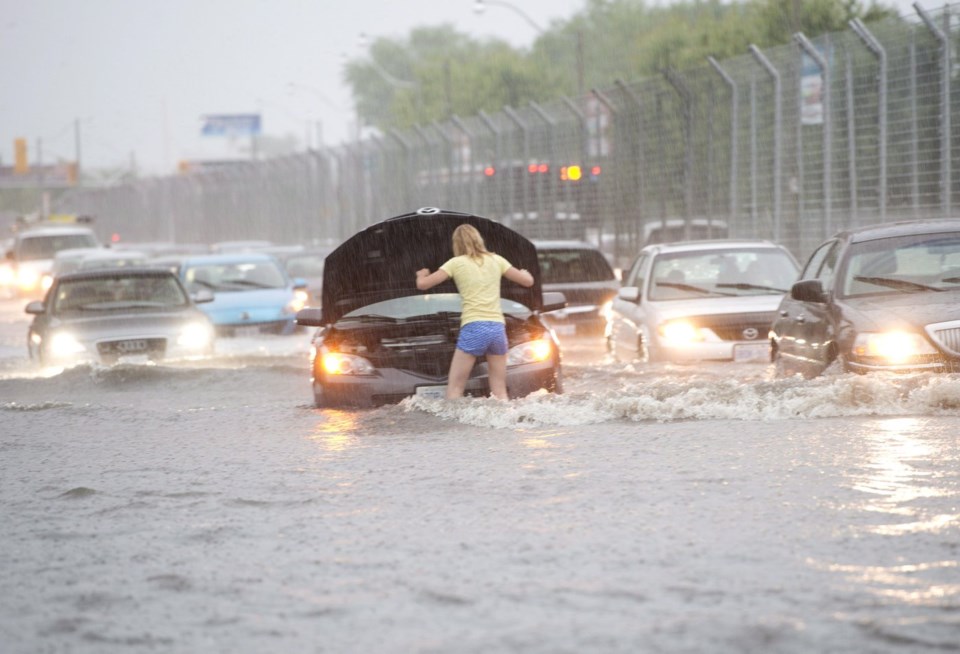MONTREAL — Jodie Weiler woke up one Saturday in 2018 to find her property strewn with debris.
“There were shingles all over the backyard and all over the sidewalk, and the back portion of our roof had come off,” she said.
A storm gusting winds of up to 125 km/h had torn through Weiler’s hometown of Kitchener, Ont., inflicting $11,770 in damage on her roof.
For Ontario as a whole, the windstorm of May 4, 2018, resulted in $380 million in damage, making it the province’s costliest weather event since the Toronto floods five years earlier, according to consultancy CatIQ.
That trend toward more destructive weather has prompted a sharp rise in home insurance rates to keep up with ballooning claims over the past decade.
The Insurance Bureau of Canada said 2024 shattered records as Canadian insurers paid out $8.55 billion for severe weather-related losses — topping 2016's all-time high of $6.2 billion in losses.
As the globe gets hotter, homeowners girding for more extreme weather can fall back on a range of renovation options to disaster-proof their property and help lower their insurance premiums.
Rain and floods
Last summer, flooding caused more than $2.5 billion in insured damage in Montreal and more than $1 billion in Toronto, affecting hundreds of thousands of homes.
Some residents could have been spared the grief with a few simple installations, said Paul Kovacs, founder of the Institute for Catastrophic Loss Reduction at Western University.
Backwater valves stop sewage from flowing into your home from inundated city pipes, and cost anywhere from $45 to $260. Kovacs cited them as the go-to step to prevent flooding.
“Water cannot back up and come into your basement when there’s a heavy rain event,” he said, noting that most older homes do not have the valves.
Sump pumps, which drain water from the basement, can also prevent serious water damage.
Those two devices alone might shave anywhere from five to 15 per cent off of a home insurance bill, said Weiler, who heads the personal solutions department at Staebler Insurance, a brokerage.
She recommends buying pumps with batteries attached or that can connect to a standby generator should the power go out — a plausible scenario in intense storms — yielding even greater savings on premiums for some plans.
Other moves, such as directing the gutter downspout so water flows away from the house, can go a long way too. “Just don’t go and send it all to your neighbour,” said Kovacs.
Hail
The Calgary hailstorm last August marked the second-costliest event in Canadian insurance history, ranking only behind the Fort McMurray wildfires of 2016. Insurers have shelled out more than $3 billion due largely to auto, roof and other building damage, according to the insurance bureau.
Impact-resistant shingles are a key shield against ice pellets. Made with polymer-modified asphalt, the shingling might cost about $3,000 on a typical home, Kovacs estimated.
“Most hailstorms are also windstorms,” he added, meaning vinyl siding is vulnerable. He recommended fibre cement siding — his own house sports the composite material — which offers a more durable alternative to traditional home cladding.
Wildfires
If you live in a wildfire-prone zone, banish anything flammable from a 1.5-metre perimeter around the house, Kovacs said.
“Don't have any shrubs, don’t put the compost and wood chips that look pretty ... Have nothing that can start a fire when embers fall on them.”
Decks and fences can be retrofitted with fire retardant-treated wood, notes the University of Waterloo's Intact Centre on Climate Adaptation. It also recommends no siding directly above the ground. Instead, metal skirting or cement boards rimming the 15-centimetre clearance area is preferred.
Fire-resistant roofs are a pricier step. Options include fibreglass-based asphalt shingles as well as concrete, slate, clay or metal tiles.
As for siding, “vinyl doesn’t do great” when exposed to high temperatures, Kovacs said. Instead, the same fibre cement products that can withstand hailstones can also handle the heat.
Co-operators and BCAA Insurance offer discounts — five per cent for the latter — to policyholders who obtain home assessments that confirm their forest fire readiness.
Wind
Roofs are the most vulnerable feature as winds start to approach hurricane force.
“When the wind goes over a roof from a tornado-strength wind or a hurricane, the roof actually starts to pull up,” Kovacs said.
One solution is hurricane clips — hundreds of them. Also called hurricane ties or straps, these 25-cent metal connectors fasten onto the roof frame and the top of the wall to resist wind uplift.
However, the work is easier done during construction than after the fact.
Should some shingles fly off during a storm, a waterproof layer between them and the roof deck can keep your interior dry.
Most of Canada's insurance companies avoid stating publicly how much lower their premiums can go as a result of these renos, but many offer lower rates to policyholders who opt for them, brokers said.
‘Peace of mind’
Provinces and municipalities often offer incentives for disaster-proofing. Toronto grants subsidies of up to $3,400 per property for products that stave off basement flooding, for example.
“If a homeowner, either on their own or with help from government, were to spend $1 to protect their home, we believe that they would avoid $5 to $10 of damage if they use that dollar to invest in the kinds of things we're talking about,” Kovacs said.
Experts stress the importance of understanding local climate risks, which vary widely by region.
"Doing any kind of preventative measures that are possible are great ideas to help prevent future claims and future issues in your home," said Weiler.
More than the savings on physical damage and insurance premiums, there’s the mental aspect, Kovacs added.
“If your home is at lower risk of having these bad things happen, you have better peace of mind.”
This report by The Canadian Press was first published Feb. 13, 2025.
Christopher Reynolds, The Canadian Press




